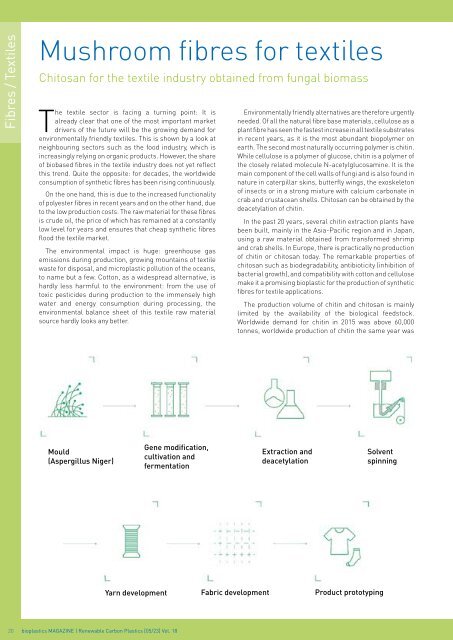Issue 05/2023
Highlights Fibres / Textiles Polyurethane / Elastomers
Highlights
Fibres / Textiles
Polyurethane / Elastomers
Create successful ePaper yourself
Turn your PDF publications into a flip-book with our unique Google optimized e-Paper software.
Fibres / Textiles<br />
Mushroom fibres for textiles<br />
Chitosan for the textile industry obtained from fungal biomass<br />
The textile sector is facing a turning point: It is<br />
already clear that one of the most important market<br />
drivers of the future will be the growing demand for<br />
environmentally friendly textiles. This is shown by a look at<br />
neighbouring sectors such as the food industry, which is<br />
increasingly relying on organic products. However, the share<br />
of biobased fibres in the textile industry does not yet reflect<br />
this trend. Quite the opposite: for decades, the worldwide<br />
consumption of synthetic fibres has been rising continuously.<br />
On the one hand, this is due to the increased functionality<br />
of polyester fibres in recent years and on the other hand, due<br />
to the low production costs. The raw material for these fibres<br />
is crude oil, the price of which has remained at a constantly<br />
low level for years and ensures that cheap synthetic fibres<br />
flood the textile market.<br />
The environmental impact is huge: greenhouse gas<br />
emissions during production, growing mountains of textile<br />
waste for disposal, and microplastic pollution of the oceans,<br />
to name but a few. Cotton, as a widespread alternative, is<br />
hardly less harmful to the environment: from the use of<br />
toxic pesticides during production to the immensely high<br />
water and energy consumption during processing, the<br />
environmental balance sheet of this textile raw material<br />
source hardly looks any better.<br />
Environmentally friendly alternatives are therefore urgently<br />
needed. Of all the natural fibre base materials, cellulose as a<br />
plant fibre has seen the fastest increase in all textile substrates<br />
in recent years, as it is the most abundant biopolymer on<br />
earth. The second most naturally occurring polymer is chitin.<br />
While cellulose is a polymer of glucose, chitin is a polymer of<br />
the closely related molecule N-acetylglucosamine. It is the<br />
main component of the cell walls of fungi and is also found in<br />
nature in caterpillar skins, butterfly wings, the exoskeleton<br />
of insects or in a strong mixture with calcium carbonate in<br />
crab and crustacean shells. Chitosan can be obtained by the<br />
deacetylation of chitin.<br />
In the past 20 years, several chitin extraction plants have<br />
been built, mainly in the Asia-Pacific region and in Japan,<br />
using a raw material obtained from transformed shrimp<br />
and crab shells. In Europe, there is practically no production<br />
of chitin or chitosan today. The remarkable properties of<br />
chitosan such as biodegradability, antibioticity (inhibition of<br />
bacterial growth), and compatibility with cotton and cellulose<br />
make it a promising bioplastic for the production of synthetic<br />
fibres for textile applications.<br />
The production volume of chitin and chitosan is mainly<br />
limited by the availability of the biological feedstock.<br />
Worldwide demand for chitin in 2015 was above 60,000<br />
tonnes, worldwide production of chitin the same year was<br />
Mould<br />
(Aspergillus Niger)<br />
Gene modification,<br />
cultivation and<br />
fermentation<br />
Extraction and<br />
deacetylation<br />
Solvent<br />
spinning<br />
Yarn development Fabric development Product prototyping<br />
20 bioplastics MAGAZINE | Renewable Carbon Plastics [<strong>05</strong>/23] Vol. 18

















